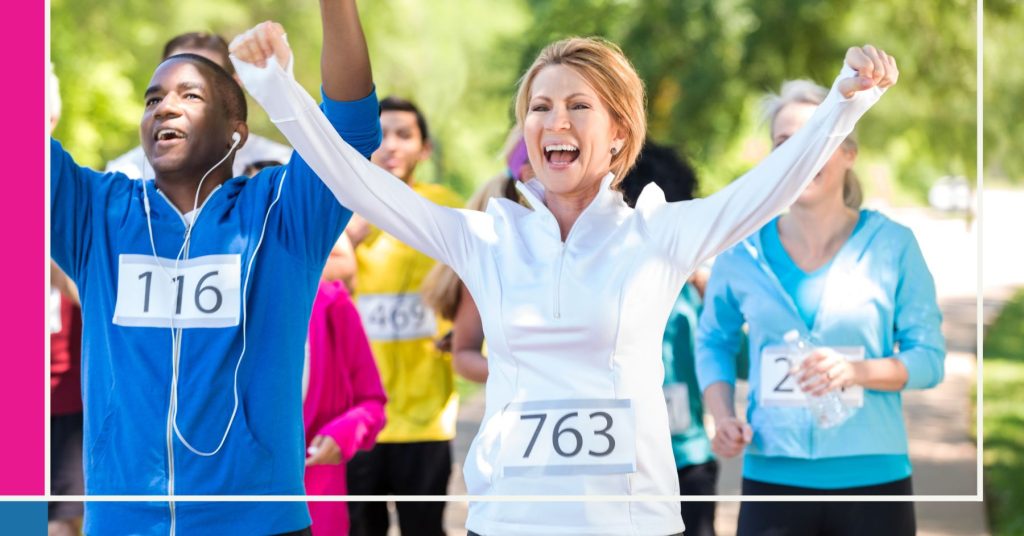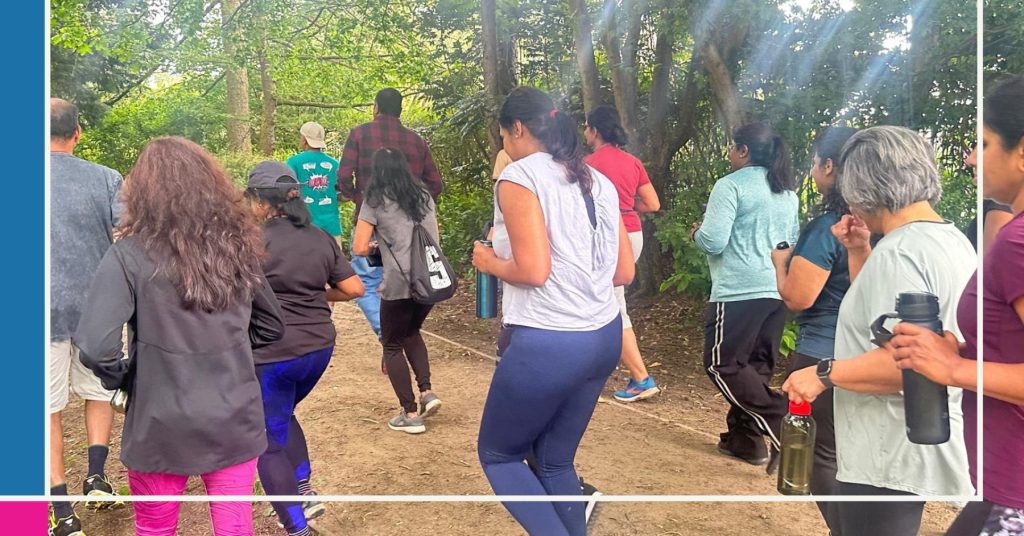Running a 5K can be a transformative experience, especially for those over 40. At this stage in life, health and well-being become even more critical, and running is a powerful way to enhance both. Whether you’re returning to running after years away or just starting, these tips for running a 5K will help you get on the right track.
The benefits of running extend far beyond just physical fitness. Running regularly can improve your cardiovascular health, boost your mental well-being, and positively shape your body. For midlife individuals, these health benefits of running are particularly significant, offering a pathway to increased resilience and vitality.
At Midlife Runners Paradise (MRP), we understand that embarking on a new fitness journey can feel daunting. That’s why our MRP framework integrates gentle running, strength training, nutrition, and mental well-being to create a holistic approach tailored for those over 40. In this article, we’ll guide you through actionable tips for running a 5K, grounded in our MRP framework, to ensure your success and help you enjoy the many benefits running can bring.
1. Tips for Running a 5K After 40: Start with a Gentle Approach
Starting a running routine after 40 requires a gentle, well-planned approach. It’s essential to ease into the process to avoid injury and build confidence gradually. One of the best tips for running a 5K at this stage in life is to begin slowly, allowing your body time to adapt to the new demands. This approach not only minimizes the risk of strain but also helps you enjoy the numerous health benefits of running, from improved cardiovascular health to better mental clarity.
At Midlife Runners Paradise, we’ve developed a specialized Gentle Couch to 5K Program tailored specifically for midlife runners. This program is designed with your unique needs in mind, offering a low to moderate intensity progression that’s manageable and effective. With heart rate-based training, strength and mobility routines, and a focus on slow, steady progress, our program ensures that you can build endurance without overwhelming your body.
Our Gentle Couch to 5K Program is ideal for those over 40, 50, or even 60, and it’s particularly beneficial for women navigating menopause. By following this structured plan, you’ll be able to run comfortably, enjoy your morning jogs without feeling breathless, and experience improved energy levels. Running will become not just an exercise, but a joyful part of your daily routine, helping you release stress and find calm. Plus, the benefits of running every day, like fat loss and better control over menopausal symptoms, make this journey even more rewarding.
Starting with a gentle approach ensures you’ll stick with it, making running a sustainable, enjoyable part of your life for years to come.
2. Prioritize Strength Training with the 80/20 Rule
When it comes to running a 5K after 40, strength training is a game-changer. Following the 80/20 rule—spending 80% of your training time on running and 20% on strength training—can significantly enhance your performance and overall body shape. Strength training doesn’t just make you stronger; it also helps you run more efficiently, reduces the risk of injury, and improves endurance, making it a crucial part of any running plan.
Incorporating strength training into your routine has numerous benefits. First, it helps you build the muscle strength needed to support your joints and maintain proper running form, which is especially important as we age. This not only improves your running performance but also minimizes the risk of common injuries like shin splints and knee pain. Additionally, strength training can lead to unexpected benefits of running, such as better balance, increased bone density, and a more toned body shape, which boosts confidence and overall health.
At Midlife Runners Paradise, we emphasize the importance of integrating strength exercises that target key muscle groups used in running—such as your core, glutes, and legs. Simple routines like squats, lunges, and planks can make a big difference when performed consistently. By prioritizing strength training alongside your regular runs, you’ll be better prepared to tackle your 5K, enjoy the process more, and see the full benefits of your efforts.
The 80/20 rule isn’t just a guideline; it’s a balanced approach that ensures your body is well-prepared for the demands of running, helping you achieve your goals safely and effectively.
3. Nutrition for Running Success: Fueling Your 5K
Proper nutrition plays a vital role in your success when running a 5K, especially if you’re over 40. As we age, our bodies require more specific nutrients to maintain energy levels, support recovery, and enhance overall health. By focusing on the right dietary choices, you can amplify the health benefits of running, making each mile you conquer more effective and enjoyable.
To fuel your 5K training, it’s important to prioritize a balanced diet rich in whole foods. Start by incorporating a variety of fruits, vegetables, lean proteins, and whole grains into your meals. These foods provide the essential vitamins and minerals needed to keep your energy levels steady and your muscles strong. Carbohydrates, in particular, are your body’s primary source of fuel during a run, so be sure to include healthy carbs like oats, brown rice, and sweet potatoes in your pre-run meals.
Hydration is another critical component of nutrition. Staying well-hydrated helps regulate your body temperature and maintain optimal muscle function, reducing the risk of cramps and fatigue. Aim to drink plenty of water throughout the day, and consider adding electrolytes to your water if you’re training in hot conditions or running longer distances.
For recovery, lean proteins such as chicken, fish, and plant-based options like beans and tofu can help repair and build muscle, supporting the running benefits body shape. Including these in your post-run meals can aid in faster recovery, reducing soreness and preparing you for your next training session.
Lastly, consider the benefits of running a mile a day as part of your overall routine. Regular, shorter runs can help maintain your fitness and keep your metabolism active, making it easier to manage your weight and improve your endurance over time. By combining consistent training with a nutrition plan that supports your goals, you’ll be well on your way to a successful 5K and a healthier, more vibrant life.
4. Mental Resilience: The Key to Completing Your 5K
Running a 5K is as much a mental challenge as it is a physical one, especially for midlife runners. Developing mental resilience is crucial to staying motivated and overcoming the inevitable hurdles that arise during training. The unexpected benefits of running go beyond physical health, with mental toughness playing a significant role in your success.
At Midlife Runners Paradise, we understand the importance of mental resilience in achieving your running goals. Our MRP framework emphasizes building this resilience by incorporating strategies like goal setting, mindfulness, and positive self-talk. These tools help you push through tough moments, whether it’s the last mile of a 5K or a challenging day when motivation is low.
The health benefits of running are well-documented, but the mental gains are equally valuable. Running regularly can reduce stress, improve mood, and boost confidence. By focusing on the mental aspects of your training, you’ll not only enhance your physical performance but also develop a stronger, more resilient mindset that extends to other areas of your life.
Cultivating mental resilience ensures you’re prepared to tackle any challenge that comes your way, making your journey to completing a 5K not just possible, but deeply rewarding.
5. Tips for Running a Mile: Building a Strong Foundation
Running a mile is an excellent way to build a solid foundation for tackling longer distances like a 5K. For those just starting out, focusing on running a mile regularly can help you develop the stamina and confidence needed to progress safely and effectively. Here are some practical tips for running a mile that can set you up for success.
First, start with a warm-up. This can be a brisk walk or light jog to get your muscles ready and reduce the risk of injury. Once you begin your run, aim for a steady, comfortable pace rather than pushing too hard. Consistency is key, so focus on maintaining that pace throughout the mile.
Incorporating running a mile into your routine offers numerous benefits. The benefits of running a mile a day include improved cardiovascular health, increased endurance, and a stronger body overall. These gains make it easier to transition to longer runs and more challenging distances over time.
Lastly, practice good form. Keep your posture upright, engage your core, and land lightly on your feet. These tips for running the mile will not only improve your efficiency but also help prevent injuries, making your mile runs more enjoyable and sustainable.
By mastering the mile, you lay the groundwork for greater achievements, preparing your body and mind for the demands of a 5K and beyond.
6. Trail Running Tips for Midlife Runners
Trail running offers a unique and invigorating way to elevate your 5K experience. For midlife runners, hitting the trails can bring unexpected benefits, from increased mental clarity to enhanced physical fitness. However, running on trails requires different strategies than running on flat surfaces. Here are some essential trail running tips to help you navigate this rewarding terrain safely and effectively.
First, invest in the right footwear. Trail running shoes are designed with deeper treads and more support than regular running shoes, providing better grip and stability on uneven surfaces. Proper footwear is crucial for preventing slips and falls, especially when running on wet or rocky trails.
Next, focus on pacing. Trails are often more challenging than paved paths due to the varying terrain, so it’s important to adjust your pace accordingly. Start slow and allow yourself time to adapt to the different surfaces and inclines. Remember, it’s okay to walk sections that are particularly steep or technical; the goal is to complete your run safely and enjoyably.
Navigation is another key aspect of trail running. Pay attention to your surroundings and stay on marked trails to avoid getting lost. It’s also helpful to familiarize yourself with the route before heading out, especially if you’re new to trail running.
Lastly, embrace the health benefits of running in nature. Trail running can reduce stress, improve balance and coordination, and even provide a greater sense of connection to the environment. The uneven terrain engages different muscle groups than road running, which helps build strength and endurance, enhancing your overall fitness.
By following these trail running tips, you can safely explore new landscapes and add variety to your 5K training. Trail running not only challenges your body in new ways but also offers a refreshing change of scenery that can reignite your passion for running.
7. Preparing for Your First 10K: Progressing Beyond the 5K
Once you’ve conquered the 5K, the next logical step is setting your sights on a 10K. Transitioning to this longer distance can be a fulfilling challenge, and with the right approach, it’s entirely achievable. Here are some key tips for running a 10K that build on the foundation you’ve already established.
The principles of the Midlife Runners Paradise (MRP) framework can be instrumental in this progression. Start by gradually increasing your mileage each week, ensuring that you’re not adding more than 10% at a time to avoid injury. Integrating the benefits of running every day, even if it’s just a mile, can help maintain your momentum and keep your body accustomed to regular exercise.
Strength training and nutrition also play vital roles in preparing for a 10K. Continue to follow the 80/20 rule, with a focus on building the endurance and muscle strength needed for longer runs. Proper nutrition is essential to fuel your longer workouts and aid in recovery, making your journey from a 5K to a 10K smoother.
Setting new goals, like running a 10K, keeps your running routine exciting and pushes you to new heights. As you embrace this next challenge, remember that consistency, patience, and the support of the MRP framework will guide you every step of the way, helping you achieve even greater running success.
Conclusion: Embrace the Journey to Lifelong Health and Happiness
In summary, running a 5K after 40 is an achievable and rewarding goal with the right approach. By starting gently, incorporating strength training, and focusing on proper nutrition, you set yourself up for success. Embracing mental resilience and considering trail running can further enhance your experience and benefits.
The Midlife Runners Paradise (MRP) framework offers a holistic path to not only achieve your running goals but also improve overall health and well-being. Our Gentle Couch to 5K Program is specifically designed to guide you from a sedentary lifestyle to a confident 5K finisher. With structured support, gradual progression, and a focus on both physical and mental wellness, you’ll find running becomes a natural and fulfilling part of your life.
Join us to transform your fitness journey, elevate your 5K experience, and embrace a healthier, happier lifestyle. Your path to lifelong health and happiness starts here.





